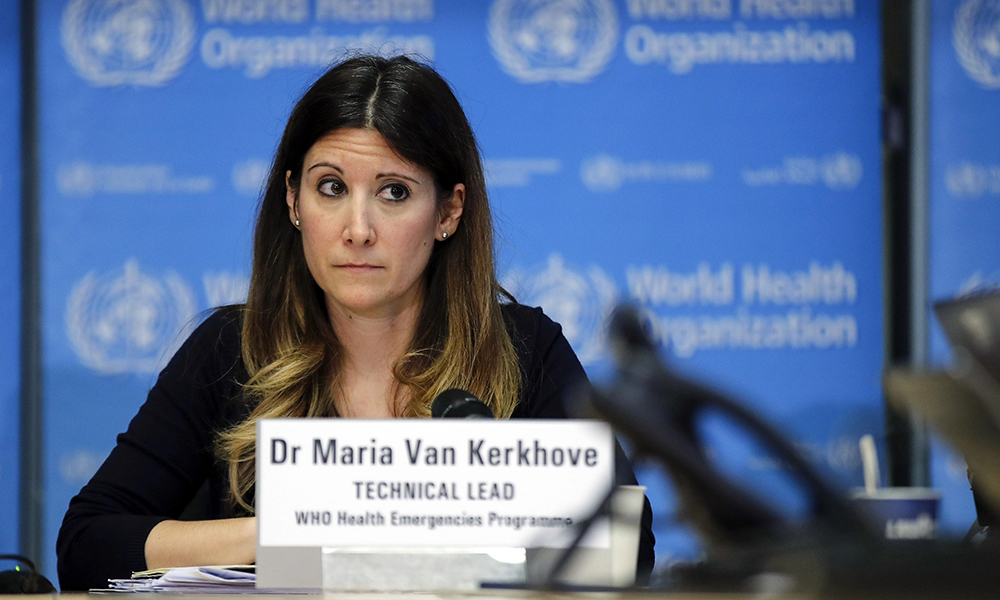
世界衛(wèi)生組織官員周三表示,,這場大流行正在接近尾聲,。但他們沒有排除劇情反轉(zhuǎn)的可能性,這種反轉(zhuǎn)可能會逆轉(zhuǎn)過去三年在疫情防治方面取得的部分(如果不是全部的話)進(jìn)展,。
“大流行的急性期正在進(jìn)入尾聲,。”世衛(wèi)組織全球傳染病危害防范和應(yīng)急準(zhǔn)備主任西爾維·布萊恩德(Sylvie Briand)博士在該組織主辦的新冠肺炎疫情網(wǎng)絡(luò)研討會上對觀眾說,。她指的是大流行的第一個階段,,通常也是最糟糕的階段,,在這個階段,新病毒會引發(fā)全球緊急情況,。世界衛(wèi)生組織上月底將新冠肺炎疫情全球衛(wèi)生緊急狀態(tài)又延長了三個月,,但指出大流行“可能正在接近拐點”。
但是,,世衛(wèi)組織突發(fā)衛(wèi)生事件規(guī)劃技術(shù)主管瑪麗亞·范·科克霍夫補充說,,“在所有人都遠(yuǎn)離風(fēng)險之前,每個人都面臨風(fēng)險”,,這種疾病會繼續(xù)演變,,并為不同國家?guī)聿煌潭鹊挠绊憽?/p>
雖然奧密克戎亞型變異株BA.5去年夏天導(dǎo)致感染病例激增,奧密克戎亞型變異株BA.5的后代繼續(xù)在全球占主導(dǎo)地位,,但“該病毒的演化模式還是不可預(yù)測的”,,世衛(wèi)組織新發(fā)現(xiàn)及動物傳染病技術(shù)官員洛倫佐·蘇比西(Lorenzo Subissi)博士告訴聽眾。
他補充說,,新冠病毒很有可能會繼續(xù)產(chǎn)生傳染性和免疫逃避性越來越強(qiáng)的變體,,這些變體是否更嚴(yán)重還未可知。
印度科學(xué)和工業(yè)研究委員會基因組學(xué)和綜合生物學(xué)研究所所長阿魯拉格·阿格拉瓦爾(Arurag Agrawal)博士提出未來可能會出現(xiàn)更嚴(yán)重的新冠病毒變體,,不管是奧密克戎還是其他變體,。
有一種流行的觀點認(rèn)為,奧密克戎是原來的新冠病毒毒株的弱化版,。但感染奧密克戎后,,病情更溫和可能是由于,至少部分是由于T細(xì)胞免疫廣泛存在于世界上許多地區(qū),。雖然T細(xì)胞不能阻止疾病,,但它們能減弱疾病的影響,往往使疾病看起來更溫和(與幾乎沒有免疫力的人群相比),,比如在取消“動態(tài)清零”措施之前的中國就存在這種情況,。
阿格拉瓦爾說:“奧密克戎會引起嚴(yán)重的疾病,它不是大自然賦予的疫苗,?!?/p>
專家表示,兩種新冠病毒變體的重組或組合是無法預(yù)測的,,如XBB.1.5,,所謂的“隱形奧密克戎”BA.2的兩種衍生毒株的組合。
XBB.1.5未表現(xiàn)出疾病嚴(yán)重程度加重的跡象,。洛倫佐說,,但專家們不能排除新冠病毒與另一種冠狀病毒完全結(jié)合的可能性——無論是在人體內(nèi)還是在動物體內(nèi),組合后的病毒還會感染人類,。
更重要的是,,隨著變體監(jiān)測的減少和對動物體內(nèi)變體的監(jiān)測一如既往地貧乏,,病毒的演化有可能已經(jīng)發(fā)生或?qū)⒁l(fā)生,而人類則措手不及,。
他說:“我們需要確保這種情況不會發(fā)生,。”他指的是通過重組產(chǎn)生新冠病毒的可能性,。
阿格拉瓦爾稱這種情況為“最壞的情況”,。
紐約智庫Kroll Institute的首席醫(yī)學(xué)顧問杰伊·瓦爾馬(Jay Varma)博士告訴《財富》雜志,他擔(dān)憂新冠病毒可能會和另一種冠狀病毒重組,,他也同樣擔(dān)憂可能出現(xiàn)更危險的新冠病毒變體。
他說:“最危險的變體將是產(chǎn)生突變,,使其逃避對嚴(yán)重疾病和死亡的預(yù)存免疫,。在這種情況下,疫苗和先前的感染將不再像現(xiàn)在這樣大大降低住院和死亡的風(fēng)險,,而且將會出現(xiàn)一場新的大流行,。”
世衛(wèi)組織小組成員周三表示,,希望目前對許多人來說病情相對溫和的模式能夠保持下去,。但是,正如專家指出的那樣,,希望并不總是與現(xiàn)實相符,。
范·科克霍夫說,現(xiàn)在大流行已經(jīng)進(jìn)入第四年,,世界各國都面臨困境,,“沒有人愿意再談?wù)撘咔榱恕薄?/p>
她說,存在這樣一種誤解,,人們認(rèn)為全球應(yīng)該結(jié)束疫情的緊急狀態(tài),,好為下一次突發(fā)事件做好準(zhǔn)備。但是,,“我們所做的一切——加強(qiáng)系統(tǒng),、建立新系統(tǒng)……都是在為下一次突發(fā)事件做準(zhǔn)備?!彼f,。
“抗擊疫情是為未來的大流行做準(zhǔn)備?!?/p>
范·科克霍夫說,,最終,這種曾經(jīng)肆虐全球的新型冠狀病毒將成為在世衛(wèi)組織努力下得到控制的眾多全球疾病之一,。
但她說,,“我們還沒有實現(xiàn)目標(biāo)”,,并補充說,她仍然“樂觀地認(rèn)為,,我們將在今年結(jié)束疫情的緊急狀態(tài),。”(財富中文網(wǎng))
譯者:中慧言-王芳
世界衛(wèi)生組織官員周三表示,,這場大流行正在接近尾聲,。但他們沒有排除劇情反轉(zhuǎn)的可能性,這種反轉(zhuǎn)可能會逆轉(zhuǎn)過去三年在疫情防治方面取得的部分(如果不是全部的話)進(jìn)展,。
“大流行的急性期正在進(jìn)入尾聲,。”世衛(wèi)組織全球傳染病危害防范和應(yīng)急準(zhǔn)備主任西爾維·布萊恩德(Sylvie Briand)博士在該組織主辦的新冠肺炎疫情網(wǎng)絡(luò)研討會上對觀眾說,。她指的是大流行的第一個階段,,通常也是最糟糕的階段,在這個階段,,新病毒會引發(fā)全球緊急情況,。世界衛(wèi)生組織上月底將新冠肺炎疫情全球衛(wèi)生緊急狀態(tài)又延長了三個月,但指出大流行“可能正在接近拐點”,。
但是,,世衛(wèi)組織突發(fā)衛(wèi)生事件規(guī)劃技術(shù)主管瑪麗亞·范·科克霍夫補充說,“在所有人都遠(yuǎn)離風(fēng)險之前,,每個人都面臨風(fēng)險”,,這種疾病會繼續(xù)演變,并為不同國家?guī)聿煌潭鹊挠绊憽?/p>
雖然奧密克戎亞型變異株BA.5去年夏天導(dǎo)致感染病例激增,,奧密克戎亞型變異株BA.5的后代繼續(xù)在全球占主導(dǎo)地位,,但“該病毒的演化模式還是不可預(yù)測的”,世衛(wèi)組織新發(fā)現(xiàn)及動物傳染病技術(shù)官員洛倫佐·蘇比西(Lorenzo Subissi)博士告訴聽眾,。
他補充說,,新冠病毒很有可能會繼續(xù)產(chǎn)生傳染性和免疫逃避性越來越強(qiáng)的變體,這些變體是否更嚴(yán)重還未可知,。
印度科學(xué)和工業(yè)研究委員會基因組學(xué)和綜合生物學(xué)研究所所長阿魯拉格·阿格拉瓦爾(Arurag Agrawal)博士提出未來可能會出現(xiàn)更嚴(yán)重的新冠病毒變體,,不管是奧密克戎還是其他變體。
有一種流行的觀點認(rèn)為,,奧密克戎是原來的新冠病毒毒株的弱化版,。但感染奧密克戎后,病情更溫和可能是由于,,至少部分是由于T細(xì)胞免疫廣泛存在于世界上許多地區(qū),。雖然T細(xì)胞不能阻止疾病,但它們能減弱疾病的影響,往往使疾病看起來更溫和(與幾乎沒有免疫力的人群相比),,比如在取消“動態(tài)清零”措施之前的中國就存在這種情況,。
阿格拉瓦爾說:“奧密克戎會引起嚴(yán)重的疾病,它不是大自然賦予的疫苗,?!?/p>
專家表示,兩種新冠病毒變體的重組或組合是無法預(yù)測的,,如XBB.1.5,,所謂的“隱形奧密克戎”BA.2的兩種衍生毒株的組合。
XBB.1.5未表現(xiàn)出疾病嚴(yán)重程度加重的跡象,。洛倫佐說,,但專家們不能排除新冠病毒與另一種冠狀病毒完全結(jié)合的可能性——無論是在人體內(nèi)還是在動物體內(nèi),組合后的病毒還會感染人類,。
更重要的是,,隨著變體監(jiān)測的減少和對動物體內(nèi)變體的監(jiān)測一如既往地貧乏,病毒的演化有可能已經(jīng)發(fā)生或?qū)⒁l(fā)生,,而人類則措手不及。
他說:“我們需要確保這種情況不會發(fā)生,?!彼傅氖峭ㄟ^重組產(chǎn)生新冠病毒的可能性。
阿格拉瓦爾稱這種情況為“最壞的情況”,。
紐約智庫Kroll Institute的首席醫(yī)學(xué)顧問杰伊·瓦爾馬(Jay Varma)博士告訴《財富》雜志,,他擔(dān)憂新冠病毒可能會和另一種冠狀病毒重組,他也同樣擔(dān)憂可能出現(xiàn)更危險的新冠病毒變體,。
他說:“最危險的變體將是產(chǎn)生突變,,使其逃避對嚴(yán)重疾病和死亡的預(yù)存免疫。在這種情況下,,疫苗和先前的感染將不再像現(xiàn)在這樣大大降低住院和死亡的風(fēng)險,,而且將會出現(xiàn)一場新的大流行?!?/p>
世衛(wèi)組織小組成員周三表示,,希望目前對許多人來說病情相對溫和的模式能夠保持下去。但是,,正如專家指出的那樣,,希望并不總是與現(xiàn)實相符。
范·科克霍夫說,,現(xiàn)在大流行已經(jīng)進(jìn)入第四年,,世界各國都面臨困境,“沒有人愿意再談?wù)撘咔榱恕薄?/p>
她說,,存在這樣一種誤解,,人們認(rèn)為全球應(yīng)該結(jié)束疫情的緊急狀態(tài),,好為下一次突發(fā)事件做好準(zhǔn)備。但是,,“我們所做的一切——加強(qiáng)系統(tǒng),、建立新系統(tǒng)……都是在為下一次突發(fā)事件做準(zhǔn)備?!彼f,。
“抗擊疫情是為未來的大流行做準(zhǔn)備?!?/p>
范·科克霍夫說,,最終,這種曾經(jīng)肆虐全球的新型冠狀病毒將成為在世衛(wèi)組織努力下得到控制的眾多全球疾病之一,。
但她說,,“我們還沒有實現(xiàn)目標(biāo)”,并補充說,,她仍然“樂觀地認(rèn)為,,我們將在今年結(jié)束疫情的緊急狀態(tài)?!保ㄘ敻恢形木W(wǎng))
譯者:中慧言-王芳
The pandemic is drawing to a close, World Health Organization officials said Wednesday. But they refused to rule out a plot twist that could reverse some, if not all, progress made on the disease over the past three years.
“The acute phase of the pandemic is ending,” Dr. Sylvie Briand, director of Global Infectious Hazard Preparedness and Emergency Preparedness at the WHO, told viewers of a COVID webinar hosted by the organization. She was referencing the first and often worst phase of a pandemic, during which a new virus presents a global emergency. The WHO late last month extended the COVID-19 global health emergency status by another three months, but noted that the pandemic “may be approaching an inflexion point.”
But “until no one is at risk, everyone is at risk” of a disease that continues to evolve and affect different countries to different extents, Maria Van Kerkhove, technical lead for COVID-19 at the WHO, added.
While Omicron subvariant BA.5, which surged this past summer, and its descendents continue to dominate globally, “the virus has not stabilized into a predictable pattern of evolution,” Dr. Lorenzo Subissi, technical officer of emerging zoonotic diseases at the WHO, told those tuning in.
COVID will, in all likelihood, continue to spawn variants that are increasingly more transmissible and immune-evasive—and they may or may not be more severe, he added.
Dr. Arurag Agrawal, director of the Council of Scientific and Industrial Research Institute of Genomics and Integrative Biology in India, raised the possibility of a more severe strain of COVID in the future, Omicron or otherwise.
There exists a popular belief that Omicron is a weakened version of the original COVID. But its generally more mild presentation is likely due, at least in part, to widespread T-cell immunity in many areas of the world. While T cells can’t stop disease, they blunt its impact, often making it appear more mild than it might in a population with virtually no immunity—like China before the lifting of “zero COVID” measures.
“Omicron can cause severe disease,” Agrawal said. “It is not nature’s vaccine.”
Recombinants, or combinations, of two COVID variants, like XBB.1.5—a mix of two spinoffs of so-called “stealth Omicron” BA.2—are a bit of a wildcard, according to experts.
XBB.1.5 has not shown signs of increased disease severity. But experts can’t exclude the possibility that COVID will combine with another coronavirus altogether—either in humans or in animals, from which it could spill back into humans, Lorenzo said.
What’s more, with variant surveillance on the decline and surveillance of variants in animals anemic as always, it’s possible such a development has occurred or will occur, and that humanity will be caught by surprise.
“We need to make sure this is not happening,” he said, referencing the possibility of a new coronavirus via recombination.
Agrawal called such a scenario “worst case.”
Dr. Jay Varma, chief medical adviser at the New York-based think tank Kroll Institute, told Fortune that the potential of recombination of COVID and another coronavirus doesn’t concern him any more than the potential of a more dangerous COVID variant.
“The most dangerous variant would be one that develops mutations that make it evade pre-existing immunity against severe illness and death,” he said. “In that situation, vaccines and prior infection would no longer greatly reduce the risk of hospitalization and death, as they do now, and there would, effectively, be a new pandemic.
WHO panel members on Wednesday expressed hope that the current pattern of relatively mild disease for many will hold. But, as experts point out, hopes don’t always align with reality.
Now in its fourth year of the pandemic, the world is in a difficult position, Van Kerkhove said, adding, “No one really wants to talk about COVID anymore.”
A misconception exists that the world should wrap up the COVID-19 emergency and prepare for the next, she said. But “everything we’re doing—strengthening systems, building new systems … that’s preparedness for the next one,” she said.
“Responding to COVID is pandemic preparedness for the future.”
Eventually, the once novel coronavirus will become one of the many global diseases the WHO works to keep in check, according to Van Kerkhove.
But “we’re still not there yet,” she said, adding that she remains “optimistic that we will end the emergency of COVID this year.”






